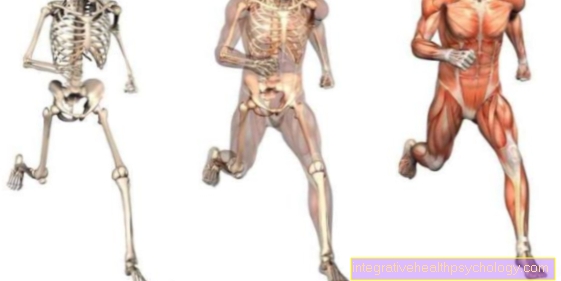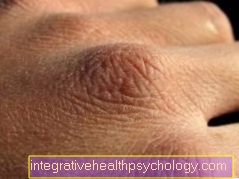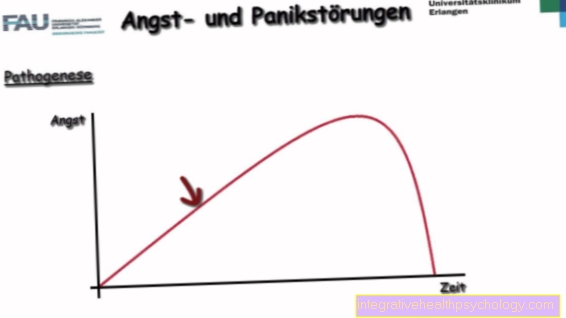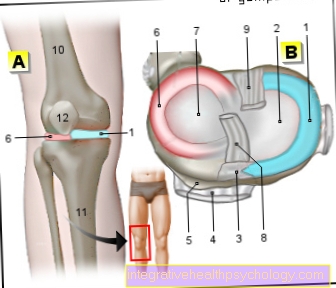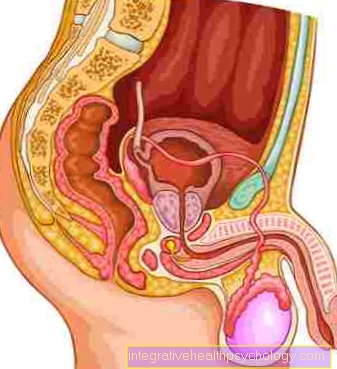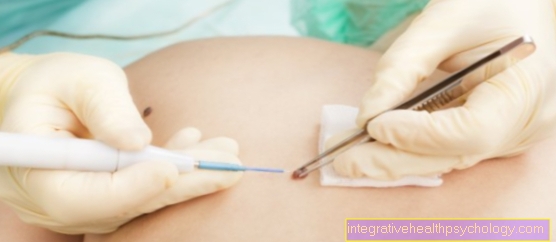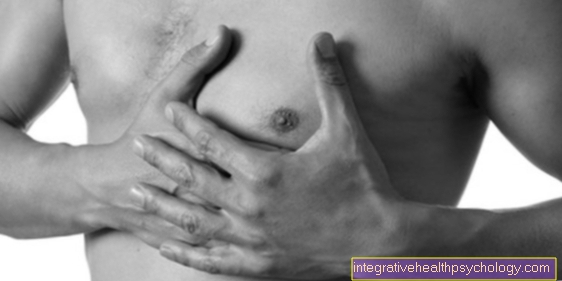Pain in the foot on the inside
introduction
The foot represents a so-called supporting organ of the body. Since the feet are important for carrying the body weight and for moving, they are supported by a tight ligament apparatus.
Bones, joints, ligaments, tendons, and muscles can be injured or inflamed, causing pain. If structures on the inside are affected, the pain can only occur locally. The pain is often noticed when standing, walking or with certain foot positions, but can also occur at rest.

Causes of pain on the inside of the foot
The causes of pain on the inside of the foot can be many. Often pain on the inside occurs due to excessive stress - for example after exercise. Even being very overweight can damage foot structures and cause pain.
However, incorrect positions of the foot or the foot-leg axis that have not been corrected can also lead to incorrect loading of the foot.
Incorrect footwear can lead to pain. For example, shoes that are too tight can cause pain. Persistent incorrect loads can have different effects on different structures of the foot.
Inflammation of the tibialis posterior tendon
The tendon of the M. tibialis posterior pulls on the back of the lower leg over the back of the medial ankle to the underside of the foot.
If the tendon becomes inflamed due to an injury or degeneration, pain can usually be felt on the inside of the foot. The pain can increase with passive outward rotation of the sole of the foot. Even when walking - especially barefoot - the pain can be felt more intensely. The tendon inflammation is caused in most cases by excessive physical activity. The overload often results from increasing training too quickly when jogging or jumping.
Flatfoot can also lead to posterior tibial tendinitis. Furthermore, the constant wearing of high heels can lead to inflammation of the tibialis posterior tendon.
Read about this too:
- Tendonitis of the tibialis posterior tendon
- Overtraining
Tarsal tunnel syndrome
Tarsal tunnel syndrome is damage to the tibial nerve. In the case of the tarsal tunnel syndrome, this nerve is constricted at the level of the inner malleolus by retaining straps (more precisely: retinaculum musculorum flexorum).
Pain occurs at the level of the inner ankle and can radiate into the heel. In addition, sensory disturbances (paresthesia) can occur on the soles of the feet. These can manifest themselves as tingling, numbness or cold and warm sensation disorders. The tarsal tunnel syndrome is often triggered by trauma such as ligament ruptures, fractures or sprains. The narrowing can also occur after operations on the ankle due to scarring.
Buckle foot
The buckle foot (pes valgus) has an inwardly inclined heel in relation to the lower leg.
Often the arched foot occurs with a flat foot, whereby the inner arch of the foot is not rounded, but lies flat on the floor. In this combination one speaks of an arched-flat foot.
In childhood, the arched foot is physiological (normal), symptom-free and in most cases grows together spontaneously.
However, if the arched foot remains, it can lead to a flat foot (pes planus), which is an extreme form of the arched foot.
This can develop through obesity, incorrect footwear, but also without an apparent cause. The development of a bent foot in adulthood happens in most cases as a result of being very overweight, but it can also have other causes, such as an injury or a defect in the muscle tendon of the tibialis posterior muscle (see paragraph above).
In the beginning, flat arched feet often experience pain behind or under the medial ankle. The pain can radiate to the lower leg. In the further course, the pain can pass into the region of the outer ankle due to additional misalignment.
Appointment with ?

I would be happy to advise you!
Who am I?
My name is dr. Nicolas Gumpert. I am a specialist in orthopedics and the founder of .
Various television programs and print media report regularly about my work. On HR television you can see me every 6 weeks live on "Hallo Hessen".
But now enough is indicated ;-)
Athletes (joggers, soccer players, etc.) are particularly often affected by diseases of the foot. In some cases, the cause of the foot discomfort cannot be identified at first.
Therefore, the treatment of the foot (e.g. Achilles tendonitis, heel spurs, etc.) requires a lot of experience.
I focus on a wide variety of foot diseases.
The aim of every treatment is treatment without surgery with a complete recovery of performance.
Which therapy achieves the best results in the long term can only be determined after looking at all of the information (Examination, X-ray, ultrasound, MRI, etc.) be assessed.
You can find me in:
- Lumedis - your orthopedic surgeon
Kaiserstrasse 14
60311 Frankfurt am Main
Directly to the online appointment arrangement
Unfortunately, it is currently only possible to make an appointment with private health insurers. I hope for your understanding!
Further information about myself can be found at Dr. Nicolas Gumpert
Heel spur and plantar fasciitis
In the case of heel spurs, tendons of the muscles that attach to the heel bone become ossified on the heel bone (calcaneus). This ossification is often triggered by incorrect loads. Overweight or foot malpositions such as flat feet or hollow feet can also promote a heel spur. Heel spur is also common in jobs that involve standing or walking.
Plantar fasciitis is a heel spur on the sole of the foot. Plantar fasciitis is more common in women, and most people are over 30 years old. Most of all, pain occurs in the morning or during exercise. Paradoxically, the pain can increase with heavy exertion - e.g. while jogging - improve too. Pain is then mainly felt on the inner heel, which can radiate towards the toes. In addition, the inner heel is often painful when pressed.
Hallux rigidus
Hallux rigidus is arthrosis (wear and tear on the articular cartilage) of the metatarsophalangeal joint of the big toe.
Osteoarthritis can be triggered by previous injuries (for example to football players), inflammation (gout, rheumatism) or age-related wear and tear.
Pain occurs mainly when the foot rolls, which can then radiate from the big toe to the inside of the foot. Standing on tiptoe is also painful.
Os naviculare externum
The external navicular bone or external tibial bone is a small additional bone on the inside of the navicular bone (navicular bone) on the foot. The navicular bone forms the arch of the foot and is part of the lower ankle joint.
The additional external navicular bone occurs in approximately 10% of the population. If the extra bone is large or in an awkward position, the tendon of the tibialis posterior muscle can be affected. This can lead to pain under the inner ankle and on the inside of the edge of the foot. The pain is particularly noticeable when walking. Constant irritation of the tendon can lead to a defect in the tendon. Since this is important for tensioning the tendon plate of the foot, weakness (insufficiency) can lead to flat feet.
Pain on the inside of the foot after localization
Pain under the inner ankle
Inner ankle pain can have many causes. For example, ligament tears or stretched ligaments (e.g. due to ankle injuries) can cause pain in this area. Even if the cartilage in the ankle is damaged - for example through inflammation - recurring pain can occur. Accidents with ankle injuries or excessive exercise can lead to joint cartilage injuries. Furthermore, misaligned feet can be the cause of pain under the medial ankle. For example, a hollow foot leads to pain under the inner ankle due to incorrect loading of the inner ankle. Pinched nerves in the area under the inner ankle - such as in the case of tarsal tunnel syndrome - can also cause pain in this region.
Read more about this under Pain in the inner ankle
Pain in the heel
Sharp pain on the underside or inside of the heel is often caused by a heel spur. This leads to a change in the tendons due to overuse, for example through running, obesity or aging. A broken heel as a result of an accident can also cause pain.
Tarsal tunnel syndrome, where a nerve becomes trapped, can manifest itself in heel pain. The pain can radiate into the calf.
Read more about this: Pain in the heel
Pain when stepping on
If pain occurs on the inside of the foot when it occurs, any structures such as bones, ligaments or tendons that are located there can be injured.
This can be a broken bone, a stretched ligament, a torn ligament or even tendon damage.
Often these injuries occur after twisting ankle, accidents or excessive exercise. Hallux valgus also causes pain in the metatarsophalangeal joint of the big toe, which is particularly felt when the foot rolls. This is a deterioration of the joint (arthrosis) of the metatarsophalangeal joint of the big toe.
Concomitant symptoms
In addition to stabbing or dull pain and pain from movement, other symptoms can also occur.
For example, if a muscle or tendon is inflamed, or if a bone is broken, swelling can also occur. In addition, fractures often lead to a loss of function. This means that the part that is broken can no longer be moved properly.
Serious injuries can also lead to nerve damage with sensory disturbances. If the tibialis posterior tendon is inflamed and painful, there may be swelling and redness in the area of the inner ankle.
Hallux rigidus can also lead to swelling of the big toe. So-called creptiations may be audible. This is a creaking sound that is made by rubbing bones and joints together. Creptitations can be heard not only with joint wear but also with fractures. In addition, changes in the foot (for example flat foot formation with buckled feet) or joint misalignments (for example after fractures) are possible.
Diagnosing pain on the inside of the foot
A medical history - i.e. asking the doctor about the cause of the accident, onset of symptoms, course, accompanying symptoms and much more - is important in order to narrow down possible causes of the pain. For example, if you experience pain after an accident or a sports injury, in many cases an X-ray must be taken to identify a possible break.
The physical exam also plays an important role. Foot malpositions such as arched arched feet or flat feet can already be determined by looking at them. Pain can also occur during passive movement of the foot: if the tibialis posterior tendon is inflamed, for example, pain occurs when the doctor passively turns the foot outwards.
Therapy of pain on the inside of the foot
Fractures often have to be immobilized with a cast so that the bone can grow back together in the correct position.
If the tibialis posterior tendon is inflamed, it is important that the foot is not subjected to any further stress and that the tendon is spared. If there is inflammation, swelling can be counteracted by cooling.
In addition, so-called non-steroidal anti-inflammatory drugs (NSAIDs) such as Iburprofen can be taken for pain and inflammation.
In the case of the tarsal tunnel syndrome, the ligamentous apparatus that causes the nerve to become trapped may have to be surgically split.
If there are movement restrictions and progressive deformities with the knee joint, this should also be treated. Physiotherapy, calf muscle stretching, and walking barefoot can help. It may be necessary to wear insoles. In rare cases, surgery is required.
The heel spur should also be treated by stretching the soles of the feet and calf muscles several times a day. Physiotherapy, taking painkillers and insoles are also used here. If overweight is the cause of the heel spur, weight reduction should take place. If these treatment approaches are ineffective, radiation therapy for the pain can be considered. If the pain remains unchanged, an operation may be necessary.
Hallux rigidus is also initially treated with physiotherapy, painkillers and insoles. If the success of the treatment cannot be seen here either, an operation will also be necessary in this case. The same applies if there is no improvement in an external navicular bone.
You might be interested in these articles:
- Insoles for a calcaneal spur
- Insoles for hallux rigidus
Duration of pain on the inside of the foot
The duration of the pain on the inside of the foot varies and depends on the underlying disease.
If, for example, excessive stress on a tendon or ligament is the cause of the pain, the pain can improve after just a few days of immobilization. Usually the pain disappears after a few weeks. It should be noted that the training is started again slowly in order to prevent renewed overload.
Inflammation of the posterior tibial tendon and fractures will heal after a few weeks with appropriate treatment. With heel spurs, however, it can take months to a year for the pain to go away. It should also be noted that half of the patients experience renewed pain in the heel spur.

